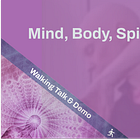What’s Old
In the last few weeks, I’ve been sharing some movement awareness exercises that I created to help me learn what I had identified as the three parts of the body that matter most in running - the shoulder girdle, the pelvic girdle, and the ankle complex. Identifying these three parts has helped me clarify what matters in training for running and also organizing training strategies. But it felt like something was missing.
What’s New
Parsing Out the Running Body
After asking Claude about the general concept of organizing the body into four anatomical parts, I realized that the missing piece was the spinal complex. I had thought about the spine as a possibility. However, I dismissed it because it seemed to me that we would inevitably train the spine, which I conceived of as including the core, when training the shoulder and pelvic girdles.
After tossing out the spine as a possibility, it struck me that the missing piece might be the diaphragm. Given the centrality of breathing to running, perhaps that was the answer.
When I presented this idea to Claude, not specific to running but just the idea of these four complexes accounting for the entire body, it pointed out that the diaphragm connects with the thoracic and lumbar spines. The thoracic spine connects with the shoulder complex and the lumbar spine connects with the pelvic girdle. Thus, adding in the diaphragm seemed to confuse things rather than clarify them.
The solution that solved the puzzle was, surprisingly, the spinal complex. The spinal complex encompasses the diaphragm and the core, both of which needed to be included for a complete running body model. It also directly connects with the shoulder and pelvic girdles. While the indirect connections the diaphragm has with these structures muddies things if we include it in the model, the direct connection the spine has with them makes the whole model pop.
While training the shoulder and pelvic girdles will, indeed, train the spinal complex as I had reasoned, I was thinking about it all wrong. In the next section, I explain the better way to think about it.
The Centrality of the Spinal Complex in Running
If we accept the idea that torso, or spinal, rotation is the primary driver of the running motion, as advocated by David Weck,1 then the spine, rather than being just one of the four complexes in running anatomy, assumes the central position. The fact that the spinal complex includes the diaphragm only emphasizes this central role given the centrality of breathing to running.
With this expansion and reordering of the running body, we create a more accurate model for training running awareness. Now, instead of isolated body parts, we have the spine in the center connecting the shoulder and pelvic girdles and influencing the ankles.2
As importantly, our model now also incorporates the dynamic rotational movement of the torso and connects the shoulder and pelvic girdles directly and the ankle complex indirectly to this rotation. We would still train each part in isolation to help build foundational awareness. But, once these foundations are in place, the goal would be to train the dynamic interconnectedness of the whole.
So that was one piece that fell, fulfillingly, into place this week. Another piece that began falling into place is flexibility.
Diving into Flexibility
This week, in addition to the movement explorations I’ve been doing, I also turned my attention to flexibility. For a year or two, I relied on long static stretch holds for my flexibility work. But, over the last year or so, this stretching approach has not felt nutritive for my body. As often happens for me in these transitional times, I have felt in limbo, the old no longer working but the new not yet clear.
What Shifted
Earlier in the week, a YouTube video popped up in my feed by MovementbyDavid (not Dave as I said in the video) that caught my attention. I can’t remember what that first video was about. However, I was struck by David’s extraordinary movement ability and subscribed to his channel. I then watched another one of his videos - a very good one - on flexibility, called The Only Flexibility Video You Need to Watch. That got me experimenting to see what kind of flexibility is right for my body now.
What’s in This Week’s Video
Taking my cue from the MovementbyDavid video, in my video for this week, I talk about the different kinds of flexibility, my experience with them, and my perspective that each is valid and valuable. The key to all training, including flexibility, I believe, is not in finding the magic bullet that resolves all our issues forever, but in learning the different bullets available to us and then working with our body to see which of the bullets is best for it (and us) for where it is (and we are) at any given time.
Something Exciting!
At the end of the video, I also share the method I came up with that my body seems to be responding well to right now. I’m excited about it. I can’t make any claims about its effectiveness at this time because I haven’t done it long enough, but I’m really curious if others like it. If you happen to try it, I would love to hear how it goes.
If you prefer a more scientific solution for stretching, watch David Thurin’s video linked below in the Mentioned in Video section. In it, he shares what the science says is the best way to stretch and for how long. Also, for some more up-to-date information on stretching, watch the excellent interview he did with Daniel Vadnal of Fitness FAQs, titled How To Get Flexible For Adults | FitnessFAQs Podcast #36 - Movement By David.
What’s Evolving
Slowly and gratifyingly, pieces are falling into place and I’m excited about where things are heading. The pieces so far are:
The four main parts of the body relevant to running
Training as a process of building awareness
Training as a process of finding what works for our body now
A promising stretching method to add to the pot of options (and potentially a stretching program)
With these pieces, I feel like a direction is emerging. It feels good :).
Mentioned in the Video
MovementbyDavid (David Thurin)
I highly recommend David Thurin’s video on flexibility, The Only Flexibility Video You Need to Watch. His breakdown of the different kinds of flexibility into two buckets - passive and dynamic - is brilliant and made it possible for me to talk about the subject in the way I do in my video. It was also the video that led me on the trail to working out my current stretching method. The name of his business is Stay Flexy.
Easyflexibility (Paul Zaichek)
I also mentioned Paul Zaichek’s stretching approach, called easyflexibility. I have not been following him recently, but I’m a big fan of his work. You can find out more about his approach on his YouTube channel, Elasticsteele. Elasticsteele, as far as I can tell, is the name that applies to his comprehensive training approach. Easyflexibility is specific to the stretching aspect of it. He has websites for each. You can find the links in the about section of his YouTube channel.
Postscript
I wanted to confirm my experience that I made progress in the straddle stretch I demonstrate in the video using my current experimental stretching method, so I took a couple screenshots. The image on the left below is my starting position. The image on the right is my ending position. That looks like progress to me. The next test will be to see if my progress sticks over time.


Updates
November 24, 2024
In the paragraph that begins “The solution that solved the puzzle was…”, the first three sentences included the word “include”. I took out the one in the first sentence and changed the second one to “encompasses” to remove the repetition. Can’t believe I didn’t catch that on my zillionth read-through before publishing :).
While I was at it, I also changed the word “seems” to “seemed” in the last sentence of the paragraph just before the “include” overuse-fix paragraph.
I’ve talked quite a bit about David Weck’s understanding of running in other posts:
It also impacts the knees, of course. My current way of resolving this issue is to conceive of the knees as part of the pelvic girdle and ankle complexes. If we think of compound movements that involve more than one joint, lower body compound movements will include the hip/pelvis, ankles, and knees. What this means is that to the extent knee issues are the result of ankle and/or pelvic mobility or strength issues, we can potentially avoid and improve a lot of knee problems by improving our pelvic and ankle mobility and strength. However, realistically, we may also need to give special attention to the knees at times.











